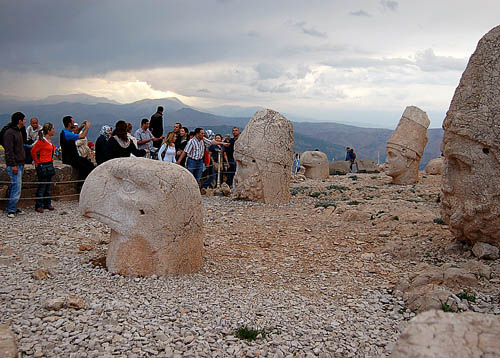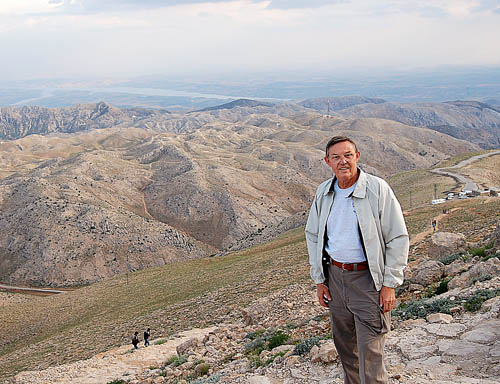Mount Nemrut in Commagene
by Ferrell JenkinsYou can't find Mount Nemrut or Commagene in your concordance? Read on and you will learn the biblical association.
The Kingdom of Commagene was located west of the Euphrates River in what is now south eastern Turkey. It is not the easiest site to get to, but well worth a visit. The rulers of Commagene claimed to be descendants of the Persian king Darius I and the Macedonian conqueror Alexander the Great. The kingdom was significant during the first century B.C. It came under Roman rule in 38 B.C. and remained an important buffer between the Romans and the Parthians until it was made part of the Roman province of Syria by Vespasian.
Mount Nemrut is slightly over 7000 feet above sea level. On the top of this mountain, overlooking the Euphrates valley, King Antiochus I Theos of Commagene built a large tumulus of small crushed stones about 150 feet high. It is thought that this may be the burial place of the king and/or of some of his family. Statues of various Greek and Persian gods were erected on both the eastern and western side of the tumulus along with his own likeness. The heads are no longer attached to the statues that were originally between 25 and 29 feet tall. Antiochus thought that by erecting his throne in such a high position it would be nearer to the heavenly throne of Zeus.
Our photo shows the western terrace at a less than brilliant sunset. In addition to the two eagle heads, a guide points to the head of Zeus. The head of Antiochus I Epiphanes is to the right. In the right foreground we see the head of Heracles.
Here is the biblical connection. Herod Agrippa I betrothed his daughter Drusilla to Antiochus IV Epiphanes, son of Antiochus of Commagene. Because he refused to embrace Judaism, this marriage never took place. Herod Agrippa II, brother of Drusilla, married her to Azizos, King of Emesa (now Homs, Syria). Drusilla dissolved this marriage and later married Felix, the Roman procurator (Acts 24:24).
At nearby Arsamea there are impressive ruins from the time of King Mithradates. The longest Greek inscriptions found in Turkey (perhaps anywhere) are located here. Ben Witherington calls them examples of Asiatic Greek and points out that they are similar to the writings of Ephesians and 2 Peter. He says that not all of the New Testament was written in Koine Greek.
The photo below shows the view of the Euphrates valley as we approach the monuments on Mount Memrut. It is a steep climb to the top. Descending is much easier!
Photos © Ferrell Jenkins 2008.
The photos may be used by others in teaching, but may not be used commercially or on web sites without permission.This article was published in Biblical Insights, January, 2008. Click here for subscription information.

